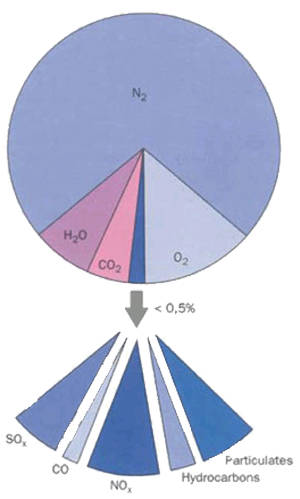Emission wiki
Commercial ships transports roughly 90% of the world's goods. Environmentally speaking the price for this transportation is the app. 3% CO2 emission that shipping is accountable for.
The emission of CO2 is an important issue for shipping, but there are other negative emissions related to operation of commercial ships.
In this area of our website you can learn more about these emissions. The text is from "Emissions from ship machinery - lecture notes" by Ph.d. student at Denmark's Technical University (DTU) Ingrid Marie Vincent Andersen. All relevant links and sources can be found in her report which can be downloaded here:
Download Emissions from ship machinery - lecture notes
Emissions in general

Figure 37 – Marine Diesel Exhaust Emission Composition.
When fossil fuel is burned in a normal combustion engine a number of different emissions will be present in the exhaust gas. Depending on the combustion conditions, the engine load, and the type of fossil fuel some or all of the following emission types will exist:
- Free Nitrogen, N2
- Free Oxygen, O2
- Water Vapour – H2O
- Carbon Dioxide – CO2
- Oxides of Nitrogen – NOX
- Oxides of Sulphur – SOX
- Hydrocarbons – HC
- Carbon Monoxide – CO
- Particulate Matter – PM
Traces of other gasses such as argon and micro pollutants in trace quantities such as polycyclic aromatic hydrocarbons (PAHs) and dioxins.
The composition of normal exhaust from a ship engine is illustrated in Figure 37.
While CO2 and SOX and partly PM are proportional to the amount of fuel burned and the sulphur content respectively the remaining emissions HC, CO and NOX vary largely with engine load.
